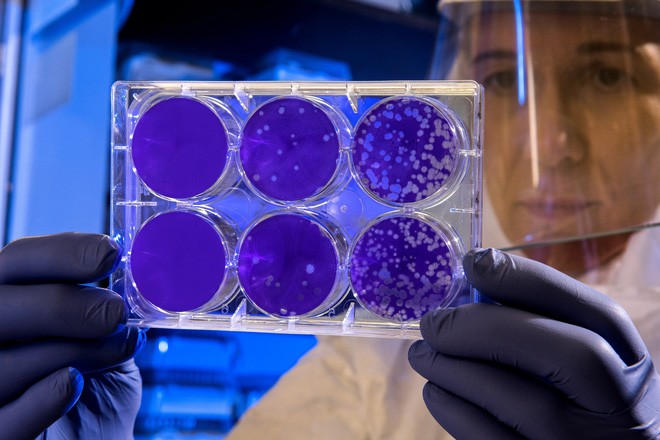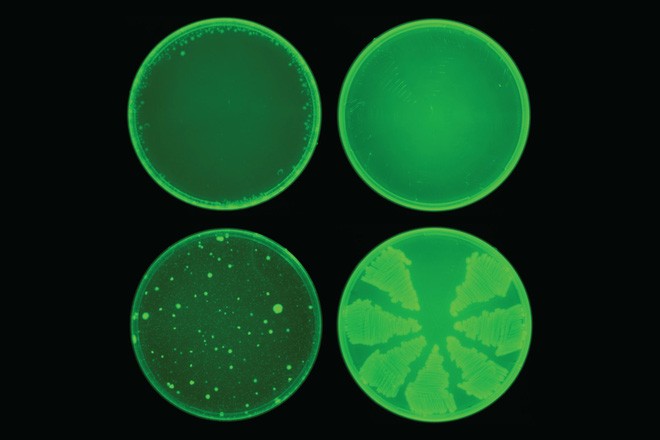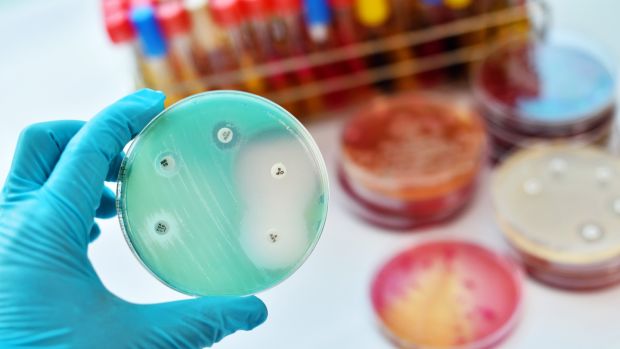The artificial neural network found that antibiotics kill bacteria that every other drug has to give up, posing more difficult questions for science
Nearly 100 years ago, Alexander Fleming discovered antibiotics and directly saved millions of people. The research process at the time was still strenuous and vague, as Fleming said: ' I'm just playing with bacteria. It also feels good to be able to break the rules and find something no one has yet discovered . '
Antibiotic research today is different, no longer having to 'play around' with bacteria with the desire to randomly find the medicine to save humanity. Today, we seek the superior computing power of machines.

In a scientific report published in the journal Cell, scientists at the Massachusetts Institute of Technology describe how they use neural networks to identify a drug compound that is different from the vast majority of antibiotics available in medicine. . The results of the study were extremely positive: when testing a new drug on mice, the team found that it fights off bacteria that no other drug can cure.
The new discovery could help combat the SARS-CoV-2 virus that is raging in many countries around the world.
With the following three big points, the new breakthrough makes us believe how artificial intelligence will change the face of medicine:
- Use neural network technology to replace the old testing method.
- Find the application of an available drug compound.
- Finding a new antibiotic that has a different mechanism from the ones we still know.
The new antibiotic molecule was named 'halicin', after the Hal 9000 artificial intelligence system in the 2001 movie: A Space Odyssey. Scientists have known for a long time that halicin can inhibit the activity of the enzyme kinase (kinase), which can cause liver damage. But until now, we only know it has the same effect as antibiotics.
This is yet another example of a new trend in medicine: discovering new effects of old medicine.

Halicin in the upper row is more effective at killing E. coli, than the current antibiotic in the lower plate.
Halicin has the ability to fight off pathogens called Acinetobacter baumannii, or A. baumannii, one of the species that is resistant to many drugs and binds all the antibiotics we have. A. baumannii is often present on hospital surfaces, attacking seriously ill people and has plagued the medical profession for many years. The World Health Organization WHO emphasizes that A. baumannii is ' one of the pathogens that need the most attention and needs urgent antibiotics '.
The big question arises: is this discovery random, or have we found a way to discover new antibiotics, to achieve more breakthroughs in the near future?
Based on the research report, we can see that scientists are based more on logic than luck. They trained the AI system to create a chemical structure model of the molecule, and it was that model that selected the most effective drug compound it thought was right, and this result was originally thought to be not scientifically valid. Feasibility.
In order to understand the logic of AI drug selection, we need to understand the difficulties scientists face, and it is also the difficulty that many artificial intelligence systems have to deal with: it is the opposite discovery of taking advantage of slots. open, looking for ways to broaden the view to get the answer but still based on what has been discovered.
Many current antibiotic studies face this dilemma, which is the opinion of the author of the scientific report Jonathan Stokes. The field of antibiotic research either creates molecules that resemble existing drugs, or is awkward in the search for drugs that look like needle in a haystack.

The solution to the problem is to raise AI to a new level. Professor Stokes and a large team of 19 experts from many MIT and Harvard laboratories have trained neural networks to identify drug molecules that can and cannot combat E. coli. Once they know what is an anti-E. coli drug, the neural network will look at a database of 6,000 drug molecules at various stages of development, and find a drug that is resistant to E. coli. , and the machine found halicin.
And surprisingly, halicin also has the ability to fend off many other bacteria, including A. baumannii. Trials show that halicin significantly repels the amount of bacteria present in mice; The sample used is A. baumannii CDC 288, which is resistant to all the antibiotics that have been used to eradicate this bacterium.
Halicin is not only an antibiotic that no one expected, but it even has its own antibacterial mechanism, an additional research topic and additional data for computer drug analysis in the future.
The key to finding this discovery lies in the neural network, which does not rely on existing information about the chemical structure of the molecule, but builds up other models for its own research.
Over the years, science has built up a library of 'chemical fingerprints' of molecules, including antibiotics. They are evidence to predict molecular activity, such as whether the substance is antibacterial. But relying only on this long-term process is not enough, so the new research applies the Chemprop method, constructing those chemical fingerprints from zero. The MIT team is behind the study. about Chemprop.
In addition to the discovery of halicin, Chemprop's way of finding 8 ' different antibacterial compounds with structures far different from normal antibiotics ', one of which was advised by MIT to be a priority for further research, because It has the ability to completely eliminate E. coli when tested in a test tube.
The new method of neural network training has even caused the medical industry to question, whether they already know how antibiotics work. This is yet another noteworthy aspect that the new breakthrough has raised.
As science continues to delve into antibiotics, we see two major advances, one for Chemprop's chemical fingerprinting method and the discovery of halicin, both of which have shown endless possibilities. of scientific discovery. We have just found a new element based on the existing knowledge, but we have opened up a new dimension to think about.
That is exactly what Alexander Fleming did nearly a hundred years ago.
You should read it
- Deep Learning - new cybersecurity tool?
- AI engineer Facebook talks about deep learning, new programming languages and hardware for artificial intelligence
- 6 steps to start learning artificial intelligence programming (AI)
- Artificial intelligence learns to create another artificial intelligence, replacing people in the future
- Instructions for new learners AI: networks of neural networks
- Admire Nvidia's new AI application: Turn MS Paint-style doodle into an artistic 'masterpiece'
- Google researchers for gaming AI to improve enhanced learning ability
- This robot only takes 2 hours to learn to walk by itself
May be interested
- Multiple choice questions about network safety deployment have the answer P1
 below network administrator will send you multiple choice questions around the topic of network security. network security is a broad topic, full of knowledge, so the following questions will help you add many useful things.
below network administrator will send you multiple choice questions around the topic of network security. network security is a broad topic, full of knowledge, so the following questions will help you add many useful things. - How to create security questions nobody can guess
 a problem that is very much concerned about is how to restore online accounts. a typical security option is to set up a security question. this has the ability to recover your account quickly and easily, but also requires a security responsibility from the user.
a problem that is very much concerned about is how to restore online accounts. a typical security option is to set up a security question. this has the ability to recover your account quickly and easily, but also requires a security responsibility from the user. - Testing computer science knowledge, doing little for fun (part 8)
 the series of computer science quiz questions covers many areas with a set of 4 answers and answers at the bottom of the page.
the series of computer science quiz questions covers many areas with a set of 4 answers and answers at the bottom of the page. - Top 10 difficult courses when applying for a job
 interview questions were summarized into 10 questions; but the probability of you being asked is more than 80% when you participated in the interview; so before the interview, you should carefully prepare information as well as practice answering well for each candidate.
interview questions were summarized into 10 questions; but the probability of you being asked is more than 80% when you participated in the interview; so before the interview, you should carefully prepare information as well as practice answering well for each candidate. - You have confidence in your knowledge of Network Administration P7
 multiple choice questions about network administration give you useful knowledge about this topic. invite readers to consult and test their knowledge.
multiple choice questions about network administration give you useful knowledge about this topic. invite readers to consult and test their knowledge. - Multiple choice questions about network security implementation have P2 answers
 security of information and network security is essential in today's 4.0 technology era. to help readers have more useful knowledge on this topic, the quiz below network administrators will send you interesting questions.
security of information and network security is essential in today's 4.0 technology era. to help readers have more useful knowledge on this topic, the quiz below network administrators will send you interesting questions. - Questions to interview IT people need to understand
 when participating in an interview for a job with the cntn, in addition to the standard interview questions, you will have to answer more specific technical questions about knowledge, skills, certificates, languages and professional tools. other. employers will want to know details about how you are equipped to solve and handle issues in the vacancy.
when participating in an interview for a job with the cntn, in addition to the standard interview questions, you will have to answer more specific technical questions about knowledge, skills, certificates, languages and professional tools. other. employers will want to know details about how you are equipped to solve and handle issues in the vacancy. - Testing computer science knowledge, doing little for fun (part 5)
 this is a series of computer science quiz questions covering a wide range of areas with a set of 4 answers and answers at the bottom of the page.
this is a series of computer science quiz questions covering a wide range of areas with a set of 4 answers and answers at the bottom of the page. - Multiple choice questions about network security implementation have the answer P5
 network security is extremely necessary for anyone. in this article, join the network administrator to learn about this topic through multiple-choice questions below.
network security is extremely necessary for anyone. in this article, join the network administrator to learn about this topic through multiple-choice questions below. - Testing computer science knowledge, doing little for fun (part 4)
 after the previous sections, network administrator continues to introduce part 4.
after the previous sections, network administrator continues to introduce part 4.










 Mitsubishi Heavy Industries ZSX - New generation 'air conditioner'
Mitsubishi Heavy Industries ZSX - New generation 'air conditioner' Scientific research: Life can exist in many places in the Universe, it is not only in the region we can observe.
Scientific research: Life can exist in many places in the Universe, it is not only in the region we can observe. How do paleontologists calculate the weight of a dinosaur?
How do paleontologists calculate the weight of a dinosaur? The largest mammoth structure ever found in Russia, shows that prehistoric humans are probably wiser than we thought.
The largest mammoth structure ever found in Russia, shows that prehistoric humans are probably wiser than we thought. Louis Vuitton purchased 40 million masks of COVID-19 for France
Louis Vuitton purchased 40 million masks of COVID-19 for France Scientists find the true cause of the giant animal extinction in Australia
Scientists find the true cause of the giant animal extinction in Australia